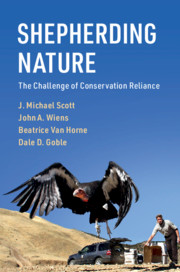Book contents
- Shepherding Nature
- Shepherding Nature
- Copyright page
- Contents
- Preface
- Acknowledgments
- 1 Extinction and the Challenge of Conservation Reliance
- 2 The Conservation Spectrum
- 3 The Genesis of Conservation Reliance and the Language of Conservation
- 4 What Are the Threats?
- 5 Emerging Threats in a Rapidly Changing World
- 6 The Role of Policy and Law
- 7 What’s in the Conservationist’s Toolbox: Species-Centered Approaches
- 8 Expanding the Conservationist’s Toolbox: Going Beyond Species
- 9 Conservation Reliance Is a Human Issue
- 10 Making Tough Decisions: Prioritizing Species for Conservation
- 11 Being a Good Shepherd
- Book part
- Essay Contributors
- References
- Index
7 - What’s in the Conservationist’s Toolbox: Species-Centered Approaches
Published online by Cambridge University Press: 28 February 2020
- Shepherding Nature
- Shepherding Nature
- Copyright page
- Contents
- Preface
- Acknowledgments
- 1 Extinction and the Challenge of Conservation Reliance
- 2 The Conservation Spectrum
- 3 The Genesis of Conservation Reliance and the Language of Conservation
- 4 What Are the Threats?
- 5 Emerging Threats in a Rapidly Changing World
- 6 The Role of Policy and Law
- 7 What’s in the Conservationist’s Toolbox: Species-Centered Approaches
- 8 Expanding the Conservationist’s Toolbox: Going Beyond Species
- 9 Conservation Reliance Is a Human Issue
- 10 Making Tough Decisions: Prioritizing Species for Conservation
- 11 Being a Good Shepherd
- Book part
- Essay Contributors
- References
- Index
Summary
The array of tools for addressing the needs of imperiled and conservation-reliant species is increasing. This chapter provides case studies and examples of the use of translocation and captive breeding for addressing threats, and discuss attributes of receiving sites. Tools for tracking species movements and for remote sensing can efficiently provide large amounts of habitat and species data. Sometimes tools can be used to address common threats such as those created by habitat change or pesticide use, benefitting multiple species. We provide Old World vultures offer a case study. Managing for surrogate, umbrella, indicator, focal, keystone, or pollinator species may assist other species as well. Such roles should be acknowledged in prioritizing conservation activities. Emerging technologies, including genetic tools and artificial intelligence, can help to address imperilment and conservation reliance if ethical issues can be navigated.
Keywords
- Type
- Chapter
- Information
- Shepherding NatureThe Challenge of Conservation Reliance, pp. 196 - 223Publisher: Cambridge University PressPrint publication year: 2020



